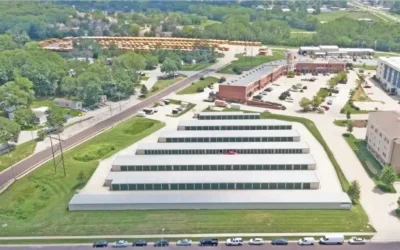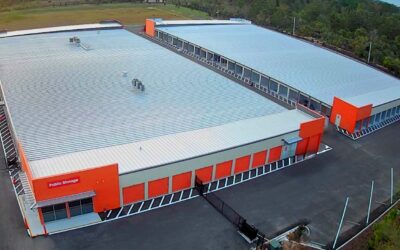Ramser Development Company has hired Adam Deermount to serve as its Chief Investment Officer. In the new role, Deermount will be responsible for directing the strategic expansion of Ramser Development’s established portfolio of storage assets across the U.S.
Ramser Development has operated in the RV and boat storage sector for the past 25 years. The firm’s portfolio includes over 1.5 million rentable square feet of RV and boat storage property and over 6,200 indoor and outdoor storage spaces.
“Demand for RV and boat storage is growing and attracting institutional capital in 2022, as is fleet storage from the logistics sector. Adam is an excellent addition to our skilled team as Ramser Development pursues new opportunities that meet our investment criteria,” said Scott Ramser, CEO and founder of the company.
Consumer purchases of boats and RVs have soared in recent years, increasing demand for storage space. Yardi Matrix reported in August 2022 that more than 2.5 million RVs and 1.6 million motorboats have been registered in the U.S. since 2017, referencing Statistical Surveys, a Michigan firm that compiles registration information. RV registrations reached an all-time high of 571,000 in 2021, while motorboat sales peaked at 325,000 in 2020.
Prior to joining Ramser, Deermount was founder and principal at RanchHarbor, a real estate private equity platform. RanchHarbor and Ramser partnered to purchase a large RV and boat facility in Altamonte Springs, FL last year.
The Storage Beat spoke with Deermount about his new role at Ramser and how he thinks the sector might be impacted by the changing economy. Read our conversation below:
Storage Beat: What led you to leave RanchHarbor and take on this new role at Ramser Development?
Adam Deermount: I started taking a deeper dive into that space and seeing what potential was there. I decided to come over and join forces with Scott and Ally Young (Chief Operating Officer) and their team and focus on this full-time as the space continues to attract more capital.
What are you most excited about?
Seeing the opportunity for growth in the vehicle and boat storage space is very exciting. The RDC team is in a unique position with 25 years of experience in the vehicle and boat storage space to capitalize on. Scott pretty much started doing this before it was cool.
What’s next? Where are you looking to expand?
We currently have 1.5 million rentable square feet across 10 projects in California and Florida. We are looking to continue to expand our growth with a focus on our primary markets of California, Florida and Texas, and a secondary focus on the Sun Belt, Mountain West and the Pacific Northwest.
We’re looking anywhere we see high ownership of boats and RVs, and some combination of growth and land constraints where the new housing that is moving through development has a high concentration of HOAs.
Why is that?
HOAs don’t tend to allow you to store an RV or boat out in your driveway. Most houses don’t have garages that can accommodate that. In markets where we see a high proportion of HOAs and a lot of growth, we see more demand for RV and boat storage.
What about the state of economy and the impact on demand? Is that a cause for concern for you?
Sales inevitably were going to slow down. Sales are going to revert to their pre-pandemic trend, but vehicles and boats are expensive durable goods. Whether the unit is owned by the original owner that bought it at a high price during the pandemic, or its sold at a fire sale price, that unit needs to live somewhere.
I think one benefit of the Ramser platform, unlike some of the newer entrants, is we have 25 years of data that indicates how this space performs over several cycles. What we tend to see is that a tenant leasing an enclosed unit may downshift to a covered unit, or covered units will want to shift to an uncovered unit. What becomes critical is unit mix, so you can accommodate those tenants and keep them on the site.
What other trends have you noticed?
Over this past development cycle one thing we have seen is new projects with newer developers have often looked down at the open parking concept a little. They put up canopies and enclosed units because capital was cheap and they could push rents, In a recession those enclosed units may fall in demand to the benefit of less expensive, uncovered spaces as people look to save money. But we’re not there yet now.
We have seen demand for fleet storage on some RV and boat facilities and usually that is more targeted at outdoor facilities because they (fleet operators) don’t care about covering delivery vehicles as much. Three of our facilities have been converted to fleet storage for large tenants that have come in and needed that in some infill markets. That’s created some opportunities on the development side, just grading land, paving it, putting fencing up, lighting and security and leasing it to a commercial tenant.
How is the economy affecting the market for buying boat and RV facilities?
Buying stabilized RV and boat property is really difficult at the moment because sellers are still anchored to what prices were for the last eight months. With the cost of permanent debt going from 4% to 7%, we’ve seen a large sentiment shift recently.
In the last 45 days there are a lot of deals have fallen out of escrow. We’re starting to see more accidental landlord situations where a developer built a facility expecting to sell at C.O. but the market is now what it is. They can either sell it for less than they planned, or become a landlord. Many of them become a landlord. The question now is how many of them will stick it out.
The market is starting to change in our favor as an acquirer. Most of our debt is long term fixed-rate debt, so we are not in a situation where we have a large percentage of our portfolio exposed to these changes.
I’d reiterate we are still active in the market and looking to buy more. We are excited about getting ramped up for some of the opportunities that dislocation will cause next year.








